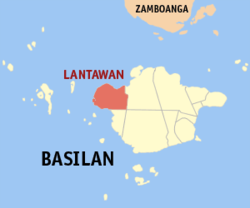Lantawan
Appearance
Lantawan | |
|---|---|
 Location within Basilan province | |
| Country | Philippines |
| Region | Bangsamoro Autonomous Region in Muslim Mindanao |
| Province | Basilan |
| District | Lone district of Basilan |
| Barangays | 25 (see Barangays) |
| Government | |
| • Type | Sangguniang Bayan |
| • mayor of Lantawan[*] | Rustam M. Ismael |
| Population (2020 census)[2] | |
• Total | 31,040 |
| • Voter (2022)[3] | 16,542 |
| Time zone | UTC+8 (PST) |
| ZIP code | 7301 |
| IDD : area code | +63 (0)62 |
| Income class | 3rd class |
| PSGC | 150703000 |
| Website | www |
Lantawan, officially the Municipality of Lantawan (Template:Lang-fil), is a municipality in the province of Basilan in the Bangsamoro Autonomous Region in Muslim Mindanao of the Philippines. The population was 31,040 at the 2020 census.[2] Template:PH electorate
On August 25, 2007, 10 of its barangays were separated and constituted into the new municipality of Hadji Muhtamad.[4][5] The municipality now only consists of 25 barangays found on Basilan Island.
Barangays
Lantawan is politically subdivided into 25 barangays.[6]
| PSGC | Barangay | Population | ±% p.a. | |||
|---|---|---|---|---|---|---|
| 2020[2] | 2010[7] | |||||
| 150703001 | Atong-atong | 7.6% | 2,368 | 1,155 | 7.44% | |
| 150703018 | Bagbagon | 2.7% | 829 | 793 | 0.44% | |
| 150703003 | Baungis | 1.7% | 524 | 515 | 0.17% | |
| 150703019 | Bulan-bulan | 4.7% | 1,463 | 1,333 | 0.93% | |
| 150703004 | Bulanza | 2.5% | 771 | 605 | 2.45% | |
| 150703037 | Calayan | 1.6% | 507 | 452 | 1.15% | |
| 150703026 | Calugusan | 2.8% | 870 | 796 | 0.89% | |
| 150703027 | Canibungan | 6.0% | 1,847 | 1,472 | 2.29% | |
| 150703029 | Landugan | 1.5% | 452 | 390 | 1.49% | |
| 150703007 | Lantawan Proper (Poblacion) | 3.0% | 919 | 943 | −0.26% | |
| 150703031 | Lawi-lawi | 3.2% | 994 | 681 | 3.85% | |
| 150703030 | Lawila | 2.1% | 643 | 467 | 3.25% | |
| 150703024 | Lower Bañas | 1.9% | 599 | 550 | 0.86% | |
| 150703008 | Lower Manggas | 3.3% | 1,025 | 598 | 5.54% | |
| 150703036 | Luuk-Maluha | 1.6% | 498 | 491 | 0.14% | |
| 150703011 | Matarling | 3.0% | 929 | 1,337 | −3.57% | |
| 150703012 | Matikang | 3.0% | 918 | 857 | 0.69% | |
| 150703033 | Pamucalin | 4.0% | 1,228 | 1,143 | 0.72% | |
| 150703035 | Paniongan | 2.0% | 612 | 524 | 1.56% | |
| 150703038 | Parian-Baunoh | 3.2% | 1,001 | 843 | 1.73% | |
| 150703021 | Suba-an (Pangasahan) | 2.9% | 895 | 516 | 5.66% | |
| 150703034 | Switch Yakal | 3.4% | 1,056 | 944 | 1.13% | |
| 150703016 | Tairan | 6.8% | 2,104 | 1,562 | 3.02% | |
| 150703025 | Upper Bañas | 1.8% | 571 | 466 | 2.05% | |
| 150703017 | Upper Manggas | 3.1% | 971 | 654 | 4.03% | |
| Total | 31,040 | 20,087 | 4.45% | |||
Demographics
|
| ||||||||||||||||||||||||
| Source: PSA[8][7][9] | |||||||||||||||||||||||||
In the 2020 census, Lantawan had a population of 31,040.[2]
Notable people
- Isnilon Totoni Hapilon, emir of the Islamic State forces in the Philippines and former leader of the Abu Sayyaf Group
References
- ^ Municipality of Lantawan | (DILG)
- ^ a b c d Census of Population (2020). "Bangsamoro (BARMM)". Total Population by Province, City, Municipality and Barangay. Philippine Statistics Authority. Retrieved 8 July 2021.
- ^ "Number of Registered Voters by Sex : 2019 National and Local Elections" (PDF). Commission on Elections. 2019.
- ^ "Muslim Mindanao Autonomy Act No. 200; An Act Creating the Municipality of Hadji Muhtamad in the Province of Basilan and for Other Purposes" (PDF). Regional Legislative Assembly, Autonomous Region in Muslim Mindanao. Archived from the original (PDF) on 4 February 2016. Retrieved 27 January 2016.
- ^ "Five (5) New Cities, Two (2) Municipalities and a Barangay created in the Third Quarter of 2007". National Statistical Coordination Board. 13 November 2007. Archived from the original on 24 November 2007. Retrieved 10 November 2016.
- ^ "Municipal: Lantawan". PSGC Interactive. Quezon City, Philippines: Philippine Statistics Authority. Retrieved 8 January 2016.
- ^ a b Census of Population and Housing (2010). "ARMM – Autonomous Region in Muslim Mindanao" (PDF). Total Population by Province, City, Municipality and Barangay. National Statistics Office. Retrieved 29 June 2016.
- ^ Census of Population (2015). "ARMM – Autonomous Region in Muslim Mindanao". Total Population by Province, City, Municipality and Barangay. Philippine Statistics Authority. Retrieved 20 June 2016.
- ^ Censuses of Population (1903–2007). "ARMM – Autonomous Region in Muslim Mindanao". Table 1. Population Enumerated in Various Censuses by Province/Highly Urbanized City: 1903 to 2007. National Statistics Office.
